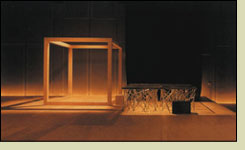
 The Mid-Air House consists of two parts: a simple post-and-lintel wooden structure that marks the space of the roji and a raised acrylic platform, resting upon a web of steel underneath, that signifies the tearoom. Like a modern sculptural installation, this construction appears complete without an actual tea ceremony taking place. Yet, facing Kitagawara’s empty tearoom, one is encouraged to partake in the tea ceremony in one’s mind as a host and as a guest.
The Mid-Air House consists of two parts: a simple post-and-lintel wooden structure that marks the space of the roji and a raised acrylic platform, resting upon a web of steel underneath, that signifies the tearoom. Like a modern sculptural installation, this construction appears complete without an actual tea ceremony taking place. Yet, facing Kitagawara’s empty tearoom, one is encouraged to partake in the tea ceremony in one’s mind as a host and as a guest. Kitagawara states his design concept: “I analyzed the tearoom as form (hardware) and space (software), and I decided to omit all forms, to simply suspend the ‘spirits’ of the guest and the host in the air.” Conventionally, the spiritual exchange between the host and the guest rely on certain forms--formality of the utensils, ornamentation, and the gestures--to be manifested. Without forms, one is led to contemplate thoroughly on the process of exchange itself.
The process of paying utmost care to and reflecting upon something is best described in the figurative expression kokoro ire. Kokoro (meaning “heart”) is to be “placed inside” (ire) an object or an objective. This process begins before the ceremony for the host as s/he prepares while it lasts after the ceremony for the guest as s/he exits the tearoom. In his own contemporary architectural language, Kitagawara articulates the importance of the heart that is to be placed inside his empty tearoom. As a summation of the way of tea, The Mid-Air House, in its metaphysical presence, conveys everything that comes in between the form and space.
Copyright © 2002 Asia Society